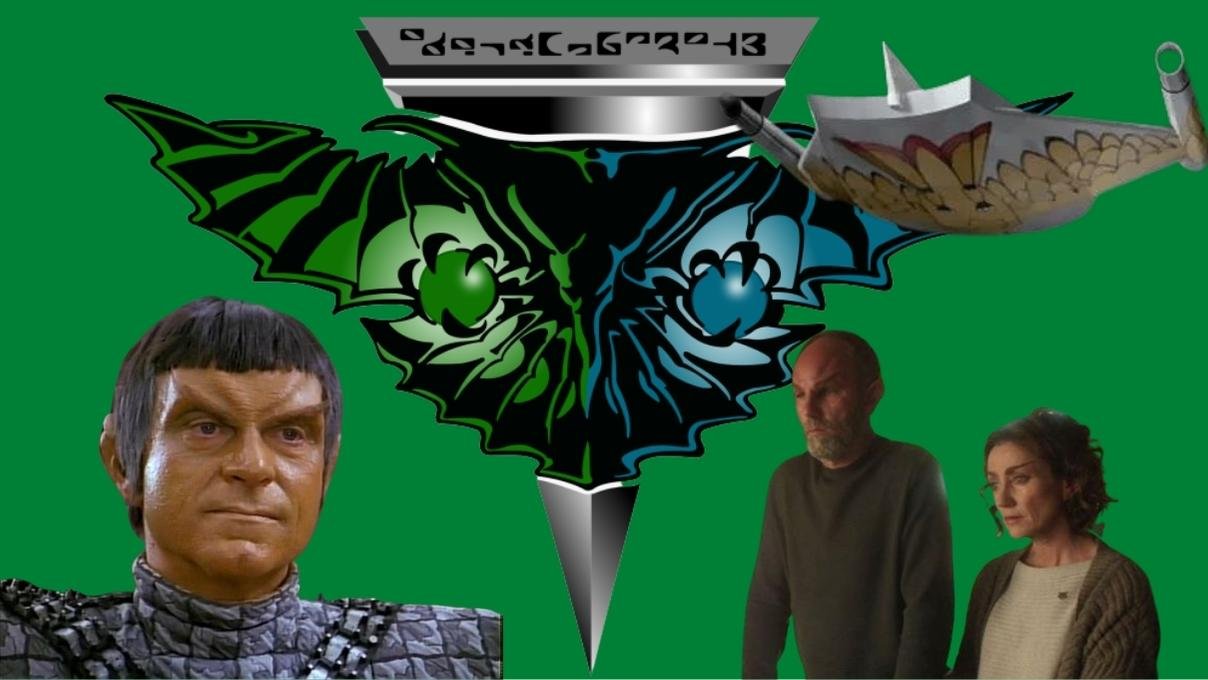T's Trek Trivia Tuesday: "The Road Not Taken"

An infinite number of parallel Enterprises exist because an infinite number of universes exist, as seen in Star Trek: The Next Generation’s “Parallels”
Parallel universes are nothing new to the Star Trek universe. In the second season of The Original Series (TOS) members of the crew found themselves in what has been dubbed “The Mirror Universe.” Since then, nearly every series has visited alternate dimensions, whether it’s Deep Space Nine (DS9) and Discovery’s (DISCO) visits to that same Mirror Universe, The Next Generation’s (TNG) fan favorite episode “Yesterday’s Enterprise,” or Voyager’s (VOY) “Year of Hell.” It seems like Star Trek: Picard (PIC) season two will explore the idea when it is released some day, hopefully soon. (For more on that, check out our FAQ page, which will be updated regularly.)
Parallel universes are created when someone makes a choice. When an individual turns left when they should have turned right, to borrow Captain Kirk’s phrase from Star Trek V: The Final Frontier. Life is made up of choices, and many decisions were made that have determined the course of our favorite franchise, for better or for worse. But what if those decisions had gone a different way? Let’s find out how much you know about the Trek that could have been.
Ensign Pavel Chekov, played by Walter Koenig, was introduced at the beginning of TOS season two. He was designed to be relatable to their teenage audience members, as well as to criticism that despite the show’s claims that all nationalities were represented on the ship, there wasn’t a single Russian to be seen. It was a forward-thinking move on Gene Roddenberry’s part, but it wasn’t the first time he had considered adding a character to the main cast.
Who was the first person Roddenberry asked to join the TOS cast?
Ensign Pavel Chekov in his first filmed scene in Star Trek: The Original Series’ “Catspaw”
The season one finale of TOS, “Operation Annihilate,” featured Kirk’s brother Sam, whose corpse was played by William Shatner himself, sporting a fake mustache. During the episode, Kirk’s sister-in-law also perished, but his nephew, Peter, portrayed by 12-year-old Craig Hundley, survived. According to Hundley, “Gene Roddenberry wanted me as a regular on the series. Because of other commitments, I was unavailable.” (At least one of those commitments was a year-long stint as Tommy McCall on the soap opera Days of Our Lives.)
If Hundley had taken Roddenberry up on his offer, would Chekov have ever existed? We’ll never know, but it’s a good bet they wouldn’t have added another new character at the beginning of season two if Peter had remained under his uncle’s care. For that matter, would Wesley Crusher have existed, or would Roddenberry have gotten his “teenage scamp running around the Enterprise” idea out of his system by the time TNG hit the airwaves?
As a side note, Hundley returned to TOS in season three’s fan-derided “And the Children Shall Lead” as Tommy Starnes. He also invented the blaster beam instrument, used in Star Trek: The Motion Picture, which we discussed in our History column last month.
“If you travel far enough, you’ll eventually meet yourself,” according to Joseph Campbell in his book Myths To Live By. For William Riker, that became a truism in the season six episode “Second Chances.” He met his own transporter clone, accidentally created and stranded on Nervala IV years earlier. As much as Commander William Riker’s experiences had shaped his personality and worldview, so had Lieutenant Thomas Riker’s. (Thomas being Riker’s middle name.) It’s a good episode and gives Jonathan Frakes a chance to show off his acting chops, playing the two separate Riker identities. But there is a world in which TNG could have been very different after the episode aired.
How could “Second Chances” have ended differently?
Riker travels far enough to meet himself in Star Trek: The Next Generation’a “Second Chances”
“Second Chances” ended with Thomas Riker leaving the ship for his new posting on the U.S.S. Gandhi. But when the writing staff was breaking the story, they floated the idea of killing William Riker and replacing him with Thomas. Data would then be promoted to First Officer and Thomas would take the helm. The idea would have shaken up the show and complicated Troi’s romantic life. For the final season of TNG and all the movies, character dynamics would have been completely different than their established norm, giving the writers, cast and audience a fresh perspective that may have been welcome, considering the number of clunkers the burned-out writers turned out in season seven. Rick Berman and Michael Piller, TNG’s producers, nixed the idea outright, however, considering it unviable for the franchise’s future.
Major Kira Nerys (Nana Visitor) was Benjamin Sisko’s Bajoran First Officer for seven years on DS9. She was tough as nails and distrustful of Starfleet’s motives in taking over the abandoned Cardassian space station. A former member of the Shakaar Resistance, her loyalties always prioritized Bajor and its people, but over the years she learned to trust Sisko and the Federation, as well. Major Kira, however, almost never existed.
Who was originally intended to be DS9’s First Officer?
Major Kira Nerys meets Commander Benjamin Sisko in the Star Trek: Deep Space Nine pilot episode, “Emissary”
Originally, TNG’s recurring Bajoran character Ensign Ro Laren (Michelle Forbes) would have been promoted and transferred to DS9. She was a very similar character to Kira, and possibly her Bajoran loyalties would have put her at odds with Sisko. It’s probably good that Forbes ultimately decided to turn down the long-term gig. It seems like a Bajoran Militia Officer such as Kira, with no previous ties to Starfleet or the Federation, made for more interesting stories and probably served the series better in the long run.
Enterprise (ENT) distinguished itself from the series that had gone before in a few ways, some more successful than others. For one thing, the prequel’s title was not prefaced with the words “Star Trek” until the third season. The opening theme was not symphonic, but rather a reworked version of Diane Warren’s “Faith of the Heart,” bearing the new title “Where My Heart Will Take Me” and performed by Russell Watson. This was a gutsy move by the producers that became the biggest controversy the show faced in its run. But there was another idea that would have taken the first season of the show in a totally different direction from any other Trek show.
How was Enterprise originally conceived to begin?
The titular vessel flies past the third season title card of Star Trek: Enterprise
In the pilot episode of Enterprise, Captain Jonathan Archer assembled a new crew and left Earth for an adventure that took them to Rigel X and eventually to the Klingon homeworld, Qo’nos. From there, they began their mission of exploration.
But when Rick Berman and Brannon Braga originally conceived the series, the entire first season was meant to take place on Earth. The show’s audience would have seen the first-ever warp-capable ship being constructed, and we would have gotten to know our main cast before they ever ventured out into space. The network, worried that this would be so far removed from previous Star Treks that it would be unrecognizable, put the kibosh on the idea.
The series Star Trek: Short Treks was devised to be a companion piece to DISCO. Each episode, lasting around 15 minutes, give or take, would tell a unique story about one of the characters. The first entry featured Cadet Tilly, who befriended an alien stowaway aboard Discovery. But that wasn’t actually the first story concept to be discussed.
What might the first episode of Short Treks have been instead?
Tilly meets Xahea’s future queen, Me Hani Ika Hali Po, in the first Short Trek, “Runaway”
According to Trek scribe Kirsten Beyer in a January 2020 TrekCore article, the very first idea for Short Treks was to have Nichelle Nichols reprise her role as Nyota Uhura. That’s when Patrick Stewart’s name came up. “…so the very first idea,” Beyer said, “was a meeting between Uhura and Picard—a very, very young Picard.”
The idea, Alex Kurtzman elaborated, “was that a young Picard had been called to a hospital where Uhura had a mission for him, and it was related to the Borg.”
The Picard idea grew, becoming Star Trek: Picard. Given Nichols’ recent retirement, making her final appearance at a convention in December, not to mention Short Treks’ uncertain future, it seems unlikely that we’ll ever see that story play out. Still, as “Mr. Spock is fond of saying, I like to think there always are…possibilities.”
T is the Managing Editor for Daily Star Trek News and a contributing writer for Sherlock Holmes Magazine and a Shakespeare nerd. He may have been the last professional Stage Manager to work with Leonard Nimoy, has worked Off-Broadway and regionally, and is the union Stage Manager for Legacy Theatre, where he is currently working with Julie Andrews. after which he’ll be working on Richard III at Elm Shakespeare Company.











